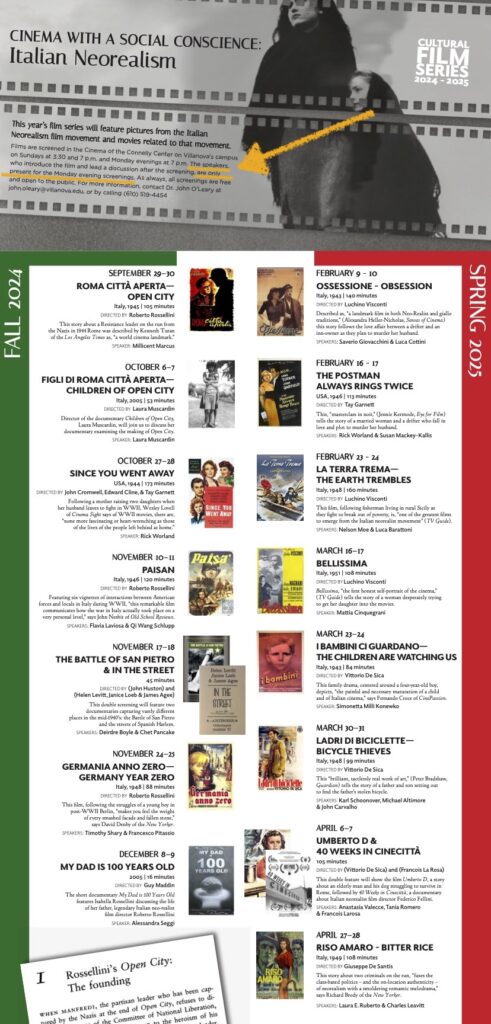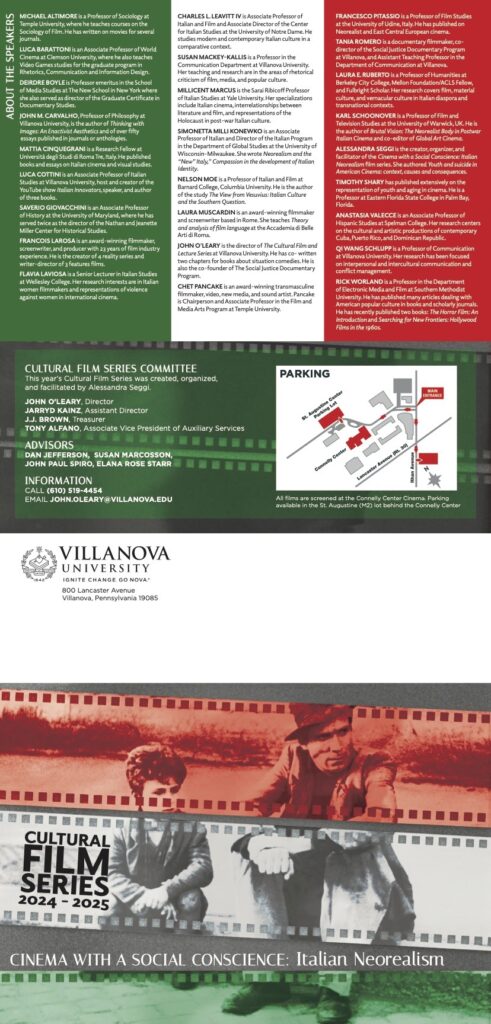Cinema with a Social Conscience: Italian Neorealism

Taking place at Villanova University, Cinema with a Social Conscience: Italian Neorealism is the film series I conceived of and have been working on since late 2022! It is scheduled for the Fall of 2024 and the Spring of 2025. Yay! The series aims to screen films by or about Neorealist filmmakers, with relevant US counterparts.

For each film, I envision a screening, plus a lively conversation between a filmmaker, a Villanova faculty member and/or another esteemed guest scholar. When I say lively conversation I mean the sort nurtured by Paul Holdengräber at the New York Public Library LIVE from the NYPL cultural series, where, he’d say, the library stone lions would roar. No matter how grave the subject of conversation, the back and forth was always infused with energetic curiosity, humor, wit, and deep reflections. I should only be so lucky as to have even one ounce of Holdengräber’s wit and knowledge!

Throughout fall 2024 and spring 2025, each film is screened on selected Sundays at 3:30PM and 7:00PM, and on selected Mondays at 7:00PM, in the Cinema, Connelly Center, at Villanova University. I facilitate introductions and conversations with leadings scholars at the Monday screenings only. Anchored in Film Studies, the discussions indeed aim to be multidisciplinary.
🎟️ 📽️ The series is free and open to the public!
🎟️ 📽️ Please note that guest speakers are present at the Monday screening only!
🎟️ 📽️ The full Cinema with a Social Conscience: Italian Neorealism 📽️ brochure complete with speakers’ bios is available below.


Why a film series on Italian Neorealism?
There are several ways in which this film series intersects with my scholarly interest in suicide and film. First, although the scholarship about Neorealism’s exquisite power and innovations in both content and form has been vast, the Neorealist portrayal of suicidality has yet to be fully analyzed. There are indeed several references to suicidality and the related social relationships in many Neorealist films—Germany Year Zero, Umberto D and Europa 51, to name a few. My next book project aims to close this gap.
Second, in chapter 8 of my book Youth and suicide in American cinema I do invoke Neorealism in order to make sense of the representations of youth, violence and suicidality in movies such as Last Days (2005), Elephant (2003), and Zero Day (2002). Here is a pertinent quote from page 197 of my book:
The unapologetic insistence on celebrating the unvarnished quotidian—as uneventful, boring, tragic, traumatizing, horrific or abject as it may be—is synonymous with Neorealism; the aim of filmmaking is “to excavate reality, to give it a power, a communication, a series of reflexes which until recently we had never thought it had” (Zavattini, 1971, p. 216). Hence, Italian Neorealist films and Last Days, Elephant, and Zero Day are alike as the antithesis to Hollywood films and American audiences’ general disinterest in the quotidian (Shary, 2002).
Even more importantly, Italian Neorealism films have had a massive influence on filmmakers all over the world: from Denmark to Brazil; from Cuba to India; from Iran to the US. This in and of itself warrants yet another festival. And as the 1940s and 1950s recede in the background of our collective memory, it is imperative to expose younger generations to these masterpieces. Isabella Rossellini herself knows about this all too well, as she reflects on her parents’ legacy in this article in People magazine.
Useful info about the location
📌 For useful information on how to reach Villanova University and suggestions about accommodation, see below.
| 📬 Where is Villanova University? 📬 | |
| 🎓 Villanova University | 📬 800 E. Lancaster Ave., Villanova, PA 19085, United States |
| 🛩️ How to reach Villanova University 🚂 | |||
| 🛩️ By plane 🛩️ | Destination: Philadelphia Int’l Airport | From the airport, you can take a cab, Uber, Lyft etc. | Time to Villanova campus: 30—40 minutes |
| 🚂 By train 🚂 | If you live relatively close to Pennsylvania, Amtrak could be a more economical option than plane (especially if booked well in advance) to reach Philadelphia central station. From there, the SEPTA regional Paoli/Thorndale train line connects to Villanova campus. | Amtrak train stop: Philadelphia – William H. Gray III 30th Street Station SEPTA regional train Paoli/Thorndale line stop: Villanova | Time to Villanova campus from Philadelphia: 30—40 minutes |
| 🛏️ Where to stay around Villanova University 🛏️ | |
| 🛏️ The Inn at Villanova | Time to Villanova campus: 2 minutes by car |
| 🛏️ The Radnor Hotel | Time to Villanova campus: 5 minutes by car |
| 🍽️ Where to eat at Villanova University 🍽️ | |
| 🍽️ Villanova University has 19 dining operations across campus. You can purchase food and drinks by credit card or with cash. |
🎞️ The screenshots from the Neorealist films featured on this page were searched on Google Images by using the film title as keyword.